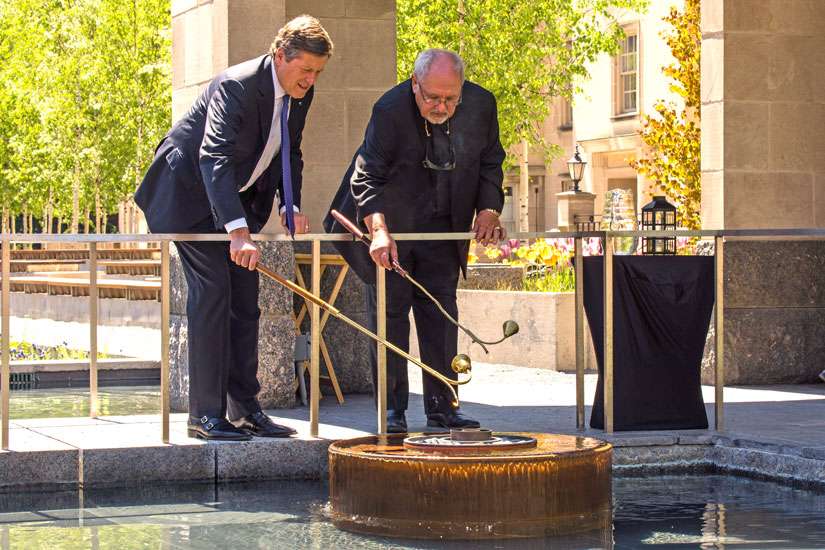The $40-million redevelopment of Nathan Phillips Square at city hall marked a milestone with a rededication of the 32-year-old peace garden in its new location along the western boundary of the square May 18. The ceremony drew the curtain on a decade of drama, tears and anger over the city’s plans to move the garden away from its central location and modernize its design.
“We stand on holy ground,” Fr. Massey Lombardi told about 300 people gathered at the new peace garden before he and Mayor John Tory relit the eternal flame from Hiroshima and added water from Nagasaki to the reflecting pool.
From 1982 to 1984, it was Lombardi, as head of the Archdiocese of Toronto’s now defunct office of justice and peace, who led a campaign to have the peace garden placed in front of City Hall, where nobody could miss it. Lombardi travelled to Japan to collect water from the fountain which commemorates 75,000 killed by the nuclear attack on Nagasaki. He worked with Canadian Hiroshima survivor Setsuko Thurlow to persuade Hiroshima mayor Takeshi Araki to share his city’s eternal flame at ground zero with Toronto.
The first shovel of sod for the garden was turned by then-Prime Minister Pierre Trudeau. The garden was officially inaugurated by Queen Elizabeth II. The eternal flame was lit and the water of peace added by Pope John Paul II in 1984.
When Toronto decided the square in front of City Hall needed a facelift in 2005, Lombardi and activists at the city’s Hiroshima Day Coalition reacted with horror.
Thurlow, who was 13 when she witnessed the city of her birth enveloped in an apocalyptic fireball, wept in frustration 10 years ago when she explained to this reporter what was at stake in the redesign of the peace garden.
“How do you explain that to the people of Hiroshima and Nagasaki, the people who shared something almost sacred to them?” Thurlow said in 2005.
The initial redesign for the garden included few elements from the original. A black granite wall replaced the pavilion as the central feature of the garden. The pavilion, designed by city architect Ken Greenberg, with its symbolically damaged roof and missing walls made explicit reference to the destructive power of nuclear weapons. Lombardi wondered what a black wall said about anything.
“Isn’t there any sense of legacy?” he asked at the time. “Isn’t there any sense of history? Isn’t there any sense of continuity? Or is everything up for grabs?”
In the end, the pavilion was preserved. It still stands beside the eternal flame and the flowing water as a warning about the cost of war in the nuclear age. The final design of the new garden won a 2016 National Award for PLANT Architect Inc. from the Canadian Society of Landscape Architects.
The new garden is larger than the old, and with more flowers and trees looks more like a garden. It also has space for gatherings of anywhere from 40 to 4,000 people. The peace garden as a focal point for protest was an essential demand of the Hiroshima Day Coalition, which has commemorated the Aug. 6, 1945 first use of nuclear weapons at the site every year since it was opened. The protest function of the peace garden was praised by Tory at the rededication ceremony. He called the garden “a refreshed and renewed place at the heart of our democracy.”
“As with most things around here, there was some controversy,” Tory conceded. But before protest, the garden’s first function is to help us remember the dead and the dying of our many wars, said Toronto poet laureate Anne Michaels.
“For over 14,000 years we’ve used flowers to honour the dead. Perhaps the first garden was a grave,” she said. “Memory is a moral muscle and it must be exercised. This garden is an act of memory.”
For Thurlow, the retired Toronto social worker who saw flesh melt off people when she was just a girl, our memory of war — nuclear and otherwise — should inspire the city to action.
“I hope that our peace garden will continue to be a beacon for Torontonians, to inspire us to take action for peace,” she said before she added the water from Nagasaki to the reflecting pool.
As far as Thurlow is concerned, there’s plenty to protest.
“We have all been forced to live in the shadow of apocalyptic destruction,” she said. “We are hostages of nuclear weapons states — nuclear weapons states who have failed to live up to their legal obligations (under the 1970 nuclear non-proliferation treaty).”
For Lombardi, who had invested so much of his hope and faith in the garden 30 years ago, the only words that would suffice were the peace prayer of St. Francis — “Make me an instrument of your peace…” he prayed before lighting the eternal flame with Tory.
For St. John Paul II, who spoke so often of the healing and purification of memory, that the world’s most diverse city finally managed to remember its dedication to peace would have been a small triumph.
“To remember Hiroshima is to commit oneself to peace,” the sainted John Paul said in 1981. “Let us promise our fellow human beings that we will work untiringly for disarmament and the banishing of all nuclear weapons.”
For the retired Lombardi, the peace garden will always stand for unfinished business.
“It is a reminder of the gap between what is and what might be,” he said.

